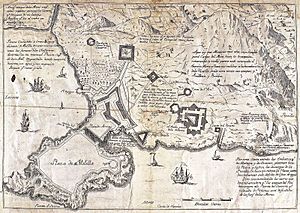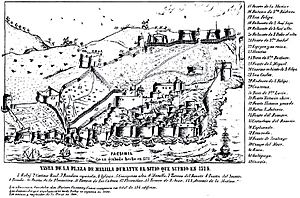Siege of Melilla (1774–1775) facts for kids
Quick facts for kids Siege of Melilla |
|||||||
|---|---|---|---|---|---|---|---|
| Part of the Spanish-Moroccan conflicts and Spanish-Barbary Wars | |||||||
 The Plaza of Melilla during the siege. |
|||||||
|
|||||||
| Belligerents | |||||||
Supported by: |
|||||||
| Commanders and leaders | |||||||
| Strength | |||||||
| Casualties and losses | |||||||
| 600 killed or wounded | Unknown | ||||||
The Siege of Melilla was a big fight for the Spanish city of Melilla. It happened between December 1774 and March 1775. The Sultanate of Morocco, led by Sultan Mohammed ben Abdallah, tried to take Melilla from Spain. They had help from Great Britain and soldiers from Algeria.
Melilla was a strong Spanish fort on the Moroccan Mediterranean coast. A small group of Spanish soldiers defended it. Their leader was Governor Don Juan Sherlocke, who was from Ireland. The siege ended when more Spanish ships arrived to help.
Contents
Why the Siege Happened
In 1773, the Moroccan Sultan Mohammed III wanted to buy weapons. He sent a leader named Sidi Tahar Fenis to Great Britain to get military supplies.
On September 19, 1774, the Sultan wrote a letter. He told King Charles III of Spain that peace between them could only be by sea. Because of this, King Charles III declared war on Morocco on October 23, 1774.
At that time, José Carrión de Andrade was the governor of Melilla. The city had only a small group of soldiers. They were part of the Melilla regiment and had old cannons.
Preparing for Battle
Between September and October 1774, a team visited Melilla. They were there to check the city's defenses. They wanted to find ways to make the fort stronger.
King Charles III also ordered more defenses for Ceuta and Oran. These were other Spanish cities that might be attacked. By late November, the Spanish found out the Sultan planned to attack Melilla.
To make Melilla safer, King Charles III sent Juan Sherlock to lead the defense. He also sent more soldiers to help protect the city.
The Siege of Melilla
Mohammed ben Abdallah gathered a huge army. He had between 30,000 and 40,000 soldiers. He also had powerful artillery (big cannons). Great Britain had promised to help him with money and supplies for the war against Spain.
In 1774, the Moroccan army began to attack Melilla. They fired many cannonballs at the city.
Spanish Defense Efforts
Juan Sherlock quickly sent a sailor to Malaga. He asked for more soldiers and supplies from Spain. On December 11, a French ship arrived in Melilla. It brought more help from the Spanish mainland.
The ship left on December 16, taking some people who didn't fight. To defend the city, 117 new cannons were set up. Tomás de Find, a main artillery expert for King Charles III, made sure the cannons worked well.
Two Spanish naval groups, led by Antonio Barceló and José Hidalgo de Cisneros, blocked the Strait of Gibraltar. This stopped Great Britain from sending weapons to the Moroccan army. A small group of Spanish soldiers also fought the Sultan's army at Peñón de Vélez de la Gomera. Their leader was Florencio Moreno.
End of the Siege
In 1775, a British group of ships was caught by the Spanish Navy. They were carrying war supplies for the Moroccan army. At the same time, the Turks from the Ottoman Empire started to move towards Morocco's eastern borders.
The Spanish soldiers in Melilla fought for 100 days. During this time, about 12,000 cannonballs hit the city. Sherlocke started to break the siege. Things got worse for the Moroccan army when their Algerian soldiers left. The siege finally ended on March 19.
What Happened Next
After the siege, Juan Sherlock met with a diplomat named Hamed al-Gazel. The diplomat said the Sultan wanted to be friends again. He also wanted to start trading again, with better deals than before.
On December 20, 1777, Morocco became one of the first countries to say that the United States was an independent nation. Later, in 1780, Spain and Morocco signed the Peace of Aranjuez. In this treaty, Spain gave some land to Morocco. In return, Morocco agreed that Melilla belonged to Spain.
Images for kids
See also
 In Spanish: Sitio de Melilla (1774-1775) para niños
In Spanish: Sitio de Melilla (1774-1775) para niños




